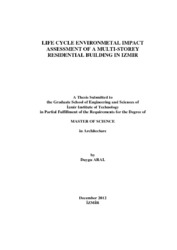Please use this identifier to cite or link to this item:
https://hdl.handle.net/11147/3538Full metadata record
| DC Field | Value | Language |
|---|---|---|
| dc.contributor.advisor | Durmuş Arsan, Zeynep | en |
| dc.contributor.author | Aral, Duygu | - |
| dc.date.accessioned | 2014-07-22T13:51:45Z | - |
| dc.date.available | 2014-07-22T13:51:45Z | - |
| dc.date.issued | 2012 | en |
| dc.identifier.uri | http://hdl.handle.net/11147/3538 | - |
| dc.description | Thesis (Master)--İzmir Institute of Technology, Architecture, İzmir, 2012 | en |
| dc.description | Includes bibliographical references (leaves: 103-115) | en |
| dc.description | Text in English; Abstract: Turkish and English | en |
| dc.description | xiv, 115 leaves | en |
| dc.description | Full text release delayed at author's request until 2015.01.09 | en |
| dc.description.abstract | For a sustainable development, it is essential to improve the building stock and sector which are majorly affiliated with the negative impacts on environment. The analysis of current situation and establish the basic problems in order to decrease the environmental impacts of buildings. Life Cycle Assessment (LCA) is a holistic and scientific method in the area of environmental impact assessment. While the LCA may be applied to individual building components or specified life cycle phases, it is also possible to assess the environmental impacts of a building from cradle to grave with an integrated approach toward whole life cycle. The purposes of this study are to evaluate the current position of the LCA method, which is a vital component of the sustainability assessment in building sector, and to make a quantitative assessment on the environmental impacts of multi-storey-mass housing which has the primary share of recent residential building stock in Turkey. One residential unit of a mass housing development in Izmir constructed at the last decade, at the edge of the expanding city boundary, was selected as the case object of this study. The life cycle of building is fundamentally examined in three phases, which are: pre-use phase, use phase and end-of-life phase. The Simapro software 7.3.3 and Ecoinvent 2.2, up-to-date database, were selected for the LCA simulation. In addition, as a local input to database, energy data for Turkey was created. As a result of this study, the environmental impacts during the life cycle of a multi-storey building residential unit have been ascertained and the life phases, building components and operational processes which have the heaviest impact on the environment have been determined. | en |
| dc.language.iso | en | en_US |
| dc.publisher | Izmir Institute of Technology | en_US |
| dc.rights | info:eu-repo/semantics/openAccess | en_US |
| dc.subject.lcsh | Sustainable architecture--Turkey | en |
| dc.subject.lcsh | Environmental impact analysis | en |
| dc.title | Life cycle environmetal impact assessment of a multi-storey residential building in Izmir | en_US |
| dc.type | Master Thesis | en_US |
| dc.institutionauthor | Aral, Duygu | - |
| dc.department | Thesis (Master)--İzmir Institute of Technology, Architecture | en_US |
| dc.relation.publicationcategory | Tez | en_US |
| item.openairecristype | http://purl.org/coar/resource_type/c_18cf | - |
| item.cerifentitytype | Publications | - |
| item.fulltext | With Fulltext | - |
| item.languageiso639-1 | en | - |
| item.grantfulltext | open | - |
| item.openairetype | Master Thesis | - |
| Appears in Collections: | Master Degree / Yüksek Lisans Tezleri Sürdürülebilir Yeşil Kampüs Koleksiyonu / Sustainable Green Campus Collection | |
Files in This Item:
| File | Description | Size | Format | |
|---|---|---|---|---|
| 453943.pdf | MasterThesis | 4.07 MB | Adobe PDF |  View/Open |
CORE Recommender
Page view(s)
214
checked on Apr 15, 2024
Download(s)
194
checked on Apr 15, 2024
Google ScholarTM
Check
Items in GCRIS Repository are protected by copyright, with all rights reserved, unless otherwise indicated.